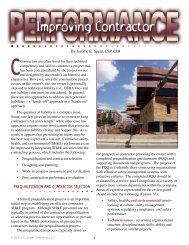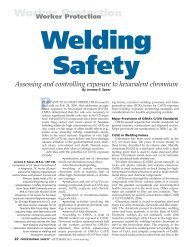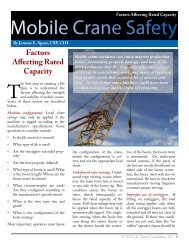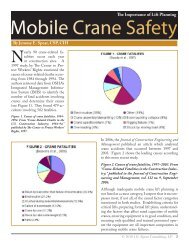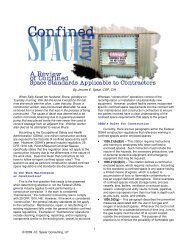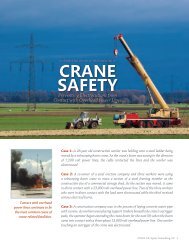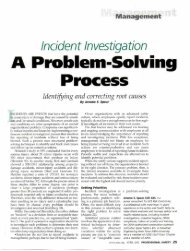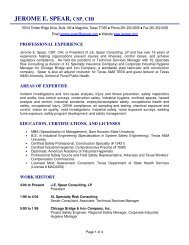Exposure Assessments - Jerome Spear
Exposure Assessments - Jerome Spear
Exposure Assessments - Jerome Spear
You also want an ePaper? Increase the reach of your titles
YUMPU automatically turns print PDFs into web optimized ePapers that Google loves.
T© J.E. <strong>Spear</strong> Consulting, LLCBy <strong>Jerome</strong> E. <strong>Spear</strong>, CSP, CIHhe exact number of occupational diseases that occur in the United States is unknown; however, mostoccupational disease cases are litigated that involve multiple defendants. By implementing a systematicexposure assessment and control process, you can help protect your company from such litigation and also protectthe health of your employees. The basic steps include the following:1. Gather information and data to characterize the project site (or facility), process, operations, work force, andenvironmental agents.2. Define similar exposure groups (SEGs) by process, task, environmental agents, and engineering controls.3. Make your best “judgment” on the exposure profile for each SEG based on available information.4. Determine the acceptability of exposure and/or need for additional exposure monitoring.5. Collect additional data and re-assess the exposure profiles as needed.Gather Available Information and DataThe first step in assessing exposures to environmental agents is to have a thorough understanding the processes,tasks, and contaminants to be studied. Information may be obtained through observations and possibly the use ofdirect-reading devices. Interviews with workers, managers, maintenance personnel and other relevant personnel(such as technical experts) provide an additional source of information and knowledge. In addition, a review ofrecords and documents (including past exposure monitoring data), relevant industry standards, and/or other literaturecan provide some insights on the magnitude of exposures for given processes and tasks performed at the work site.The information gathered is then used to both define similar exposure groups (SEGs) and also to make the initialjudgments on exposures.Define Similar <strong>Exposure</strong> GroupsThe goal of defining SEGs is to minimize the variability of exposure monitoring data. For highly dynamic work siteswhere activities and related exposures may vary significantly from day-to-day (e.g., activities performed onconstruction sites), SEGs should be categorized by the tasks or activities being performed. Categorizing SEGs byprocess, task, environmental agent, and engineering controls are often the preferred option as opposed to definingSEGs by title and/or occupation. For example, welding has the potential of generating metal fumes and fluorides inaddition to other gases. For this example, the SEGs may be defined by the specific welding technique, the type ofmaterial being welded and welding consumable, the welding task, the environmental agent, and the engineeringcontrols (see Figure 1). The objective in defining SEGs is to minimize the variation between air-sampling results.Figure 1 – Sample SEGs for Welding TaskSEG Welding Technique and Task Material/WeldingConsummableEnvironmental Agent Use ofLEV?1 Flux-core arc welding bottom-to-shell Stainless steel Metal fumes Noplate corner seam2 Flux-core arc welding bottom-to-shell Stainless steel Hexavalent chromium Noplate corner3 Flux-core arc welding bottom-to-shell Stainless steel Fluorides Noplate corner seam4 Flux-core arc welding bottom-to-shell Stainless steel Ozone Noplate corner seam5 Flux-core arc welding bottom-to-shell Stainless steel Nitrogen oxides Noplate corner seamLEV – Local exhaust ventilation1
Profile the <strong>Exposure</strong>After the SEGs are defined and categorized by process, task, environmental agent, and engineering controls, ajudgment can be made about the exposure profile for each SEG, using the information collected on the agent’stoxicity and relevant sampling data that is available. The exposure judgment consists of assigning an exposurerating, health effects rating, and uncertainty rating to each SEG. These qualitative ratings are used to determine theacceptability of the exposure profile, identify the need of additional exposure monitoring, and prioritize the datacollection needs.An exposure rating is an estimate of exposure level relative to the applicable occupational exposure limits (OELs).<strong>Exposure</strong> ratings assist with streamlining the assessment process, particularly during initial assessments whenmonitoring data are often sparse.If there is a lack of exposure monitoring data available, the initial exposure profile may merely be a “best guess”based on professional judgment and assumptions, which leads to a highly uncertain exposure rating. The exposurerating may also be based on the relative exposure levels, surrogate data (i.e., exposure data from another SEG),and/or exposure modeling but the method of judging the exposure level affects the uncertainty rating.Uncertainty is a function of 1) confidence in the health effects data; 2) confidence in exposure rating; and 3) reliabilityof existing controls. For each SEG, an uncertainty rating is qualitatively assigned. A high uncertain rating usuallycorresponds to uncertain judgments made when significant information on the exposure profile or health effects ismissing. Assigning exposure ratings on merely subjective information and/or assumptions tends to lead to a highlyuncertain exposure rating as discussed above.The health effects rating is based on the toxicity of the environmental agent and is a factor in assessing the exposurerisk and prioritizing additional exposure monitoring needs. For example, the health effects rating of a carcinogenicsubstances (such as hexavalent chromium) would be higher than the health effects rating of a substance thatprimarily has irritating effects (such as ozone). A rating scheme for categorizing exposure judgments, health effects,and uncertainty level is provided in Figure 2, which is based on AIHA’s A Strategy for Assessing and ManagingOccupational <strong>Exposure</strong>s, 2 nd .CategoryFigure 2 – <strong>Exposure</strong> Assessment Rating SchemeJudgment of <strong>Exposure</strong> Relative to the OEL4 Greater than the applicable occupational exposure limits (OEL).3 50% to 100% of the applicable OEL.2 10% to 50% of the applicable OEL.1 Less than 10% of the applicable OEL.CategoryHealth Effect4 Life-threatening or disabling injury or illness.3 Irreversible health effects of concern.2 Severe, reversible health effects of concern.1 Reversible health effects of concern.0 Reversible effects of little concern, or no known or suspected adverse health effects.CategoryUncertainty Description3 Highly Uncertain: <strong>Exposure</strong> judgment made without any available exposure monitoring data.Adverse effects are uncertain and/or there is no consensus OEL available.2 Uncertain: <strong>Exposure</strong> judgment made using limited exposure monitoring data from a surrogateSEG or judgment was made based on exposure modeling. Adverse effects are uncertain and/orthere is no consensus OEL established.1 Somewhat Uncertain: <strong>Exposure</strong> judgment made using limited data representing the same SEGor using substantial exposure monitoring data from a surrogate SEG. OELs are available for theagent.0 Certain: <strong>Exposure</strong> was profiled using with substantial exposure monitoring data available specificto the SEG. Adverse health effects for the agent are well documented with established OELs.Based on AIHA’s A Strategy for Assessing and Managing Occupational <strong>Exposure</strong>s, 2 nd .© J.E. <strong>Spear</strong> Consulting, LLC2
Determine the Acceptability of <strong>Exposure</strong>For each SEG, categorize the exposure profile as being acceptable, unacceptable, or unknown (i.e., not enoughinformation). For unacceptable exposure profiles, determine and prioritize appropriate control measures by risk ofexposure (i.e., exposure level and health effects). For acceptable exposure profiles, determine whether routinemonitoring is required to ensure the exposure profile remains acceptable. A threshold of 10% of the OEL isrecommended (by AIHA) as a trigger for beginning to collect exposure-monitoring data to support the exposurejudgment in order to establish adequate confidence in the exposure assessment.For SEGs that have uncertain exposure profiles, prioritize further exposure monitoring and/or information gatheringneeds by both the risk of exposure and the uncertainty rating of the exposure profile. The information gatheringpriority rating is calculated by the following:Information gathering priority rating = (<strong>Exposure</strong> Rating) x (Health Effects Rating) x (Uncertainty Rating)For example, a particular painting task may be expected to exceed the OELs and would be assigned an exposurerating of 4 accordingly. Based on a review of the material safety data sheet and health effects of the organic vaporconstituents associated with this paint, a health effects rating of 3 was assigned. Since the initial exposure judgmentwas made based on exposure monitoring data collected for a similar task but involving a different paint product, anuncertainty rating of 2 was assigned. As a result, the priority rating was calculated to be 24 (i.e., 4 x 3 x 2). Thepurpose of calculating the priority rating is to establish an information gathering priority ranking among SEGs so thatyou can efficiently utilize your resources.Collect Additional Information and <strong>Exposure</strong>Monitoring DataFurther information gathering needs may include conducting additional exposure monitoring, gathering additionalinformation about the health effects of the agent, and/or obtaining other information that would lower the uncertaintyrating. A consideration when collecting additional exposure monitoring data is the sampling strategy. <strong>Exposure</strong>monitoring can either incorporate a worst-case sampling strategy or a random sampling strategy. A worst-casesampling strategy involves subjectively selecting and collecting personal air samplings that are considered torepresent the worst-case exposure for each SEG. A random sampling approach is a more quantitative exposuremonitoring strategy in which 6 to 10 random samples within the SEG are collected and statistically analyzed and usedto calculate an upper confidence limit of the mean concentration for the SEG. A random sampling approach results inhigher confidence level (i.e., a low uncertainty rating) exposure judgment than a worst-case exposure monitoringstrategy since a worst-case sampling strategy relies on subjectively identifying the “worst-case” exposure. Theadditional exposure monitoring data also allows for the comparison of the exposure profiles of each SEG todetermine if any of the SEGs should be re-classified.Quality control guru, W. Edwards Deming, taught us that “improvement is not a one-time effort; management isobligated to improve continually.” Continuous improvement in occupational health is no exception. Assessingoccupational exposures to environmental agents should be a continuous process so that engineering and otherexposure control efforts can be continuously improved. The process of gathering basic information about potentialexposures, defining similar exposure groups, profiling the exposures, determining the acceptability of exposure, andprioritizing and gathering additional exposure monitoring data provides a systematic method of protecting the healthof your employees.ReferencesMulhausen, J. and Damiano, J., ed. A Strategy for Assessing and Managing Occupational <strong>Exposure</strong>s, 2 nd Edition.Fairfax, VA: AIHA Press, 1998.Walton, M. The Deming Management Method. New York, NY: The Berkley Publishing Group, 1986.© J.E. <strong>Spear</strong> Consulting, LLC3
Figure 3 – A Process for Evaluating and Managing <strong>Exposure</strong>sGather informationand availableexposure data.ObservationsInterviews with workers, management,and technical expertsReview of records, MSDS, and previousexposure monitoring dataCategorize similarexposure groups(SEGs).ProcessTaskEnvironmental agentEngineering controlsConduct exposuremonitoring and/orobtain additionalinformation.Make a “judgment”about the exposureprofile for each SEG.<strong>Exposure</strong> RatingHealth Effects RatingUncertainty RatingRisk Rating = <strong>Exposure</strong> Rating X HealthEffects RatingPrioritize additionalinformation gatheringneeds.?Is the exposureacceptable?YesIs periodicmonitoring of SEGneeded?NoYesPriority Rating = RiskRating X UncertaintyRatingDetermineappropriateengineeringcontrols.Implement a periodicmonitoring schedule.NoDocument acceptableexposure profile.New SEGImplementfeasibleengineeringcontrols.Prioritize theimplementation ofrecommendedcontrols.19314 Timber Ridge Drive, Suite 100Magnolia, Texas 77355Phone (281) 252-0005jerome.spear@jespear.comwww.jespear.com© J.E. <strong>Spear</strong> Consulting, LLC4



